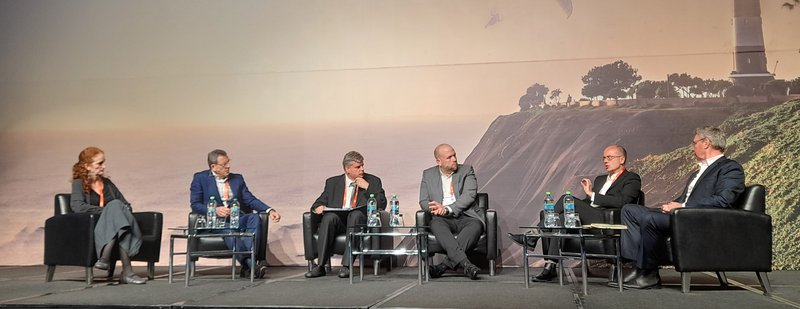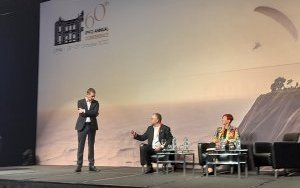IFFO – The Marine Ingredients Organisation’s 60th Annual Conference was held in Lima, Peru highlighting the continuous improvement in responsible raw material sourcing while playing to its strengths, excellent nutrition, low environmental impacts, and resilience.
IFFO’s president, Gonzalo de Romaña, opened the event by explaining the vital role of marine ingredients in the global food system. FAO’s latest State of the World’s aquaculture and Fisheries Report (2022) states that the total production of farmed and wild fish in 2020 was 178 million MT. IFFO estimated that in 2020, 35% was tonnage farmed by using compound feed including fishmeal and fish oil. Considering that the average consumption of fish worldwide was reported at 20 kg per capita in 2020, 35% of that was produced thanks to fishmeal and fish oil. In other words, 7 kg of the 20 kg fish per capita consumed in 2020 were farmed using fishmeal and fish oil.
The world needs marine ingredients
IFFO’s director general, Petter Martin Johannessen, noted that “a secure future relies on both nutritious and sustainable foods” and with decades of data, marine ingredients provide a benchmark for aquafeed ingredients for which the performance of other ingredients is measured. The many benefits that these valuable ingredients provide are well known.
“To feed the world, we need to waste less fish, and with 70% of the fish often going to waste, we need to use 100%. The marine ingredients sector provides the market in which fish byproducts are put to the most efficient use. Today, 30% of fishmeal and 51% of fish oil are produced from byproducts,” said Johannessen. “The increasing availability of sustainable marine ingredients is the only way forward to feed a growing population and more importantly, to nourish it. Quality food requires quality feed.”
Fishmeal market
IFFO’s market research director, Enrico Bachis, said that the largest fishmeal exporters are Peru, followed by China, Vietnam and Denmark. Countries with a large aquaculture sector tend not to export fishmeal. For imports, China is the largest importer (almost 50%) of global imports, followed by Norway and Japan, which again have large aquaculture industries.
Historical trends on fishmeal use show that use continues to grow in the aquaculture sector, poultry and pig sectors are slightly reducing, while pet food is growing. Regarding aquaculture, sector growth is happening fastest in Asia and China, and for species, crustaceans (shrimp) are increasing along with freshwater fish, especially in China. Finally, salmonids are the fourth sector in terms of the consumption of fishmeal.
Fish oil market
Peru is again the leader in exports of fish oil, followed by Denmark, Norway and China, Enrico Bachis said. For imports, Norway is the leader followed by other aquaculture-producing countries.
Looking at the use of fish oil, salmon is the dominant consumer, followed by crustaceans and then marine fish. By regions, feed formulations greatly affect consumption and Europe is therefore the leader, followed by Latin America. Consumption by the pharmaceutical sector increased by 5% and this is expected to continue.
Chr. Holtermann AS managing director, Christian Meinich, said that with prices at an all-time high, the last six months have been more of a balancing act, driven in part by lower production levels and strong demand from China for omega-3. Rapeseed markets have been severely impacted becoming inflated earlier in the year due to the war in Ukraine, with interest growing in algae-based products, but they too have suffered from production bottlenecks.
Menhaden production has been high, but Peru fishing and other markets have been lower. The difference between rapeseed oil and fish oil impacts the EPA and DHA value, which has sky-rocketed in recent months to historic levels. The outlook for 2023 is expected to be a similar balancing act and the continued impacts of the uncertain access to rapeseed oil will continue to disrupt the market. “This will likely drive more demand for alternative sources (algae), which currently has a small market share, and this will likely increase gradually,” Meinich said.
GOED’s vice president of data science, Aldo Bernasconi, said that pharmaceutical approvals in China for omega-3 drugs are in the pipeline which could greatly impact markets.
As for supply chains, Maersk’s global director of The Fish & Seafood Segment, Thue Barfod, said that ongoing additional challenges include stretched supply chains, China’s dynamic “zero” COVID policy, employment challenges, fuel increase, inflation, and other geopolitical challenges.

Fisheries
Cayetana Aljovín from the Peruvian Sociedad Nacional de Pesquerías (SNP) said that currently, the anchoveta biomass is stable and and healthy, and is around 10 million MT. Through a series of circular economy measures, the industry has achieved an efficiency of more than 43%, with 6MT of anchoveta going to 1MT of fishmeal in the past to 4.2 MT of anchoveta going to 1MT of fishmeal nowadays. Water treatment plants are also in place along with an energy mix of natural gas to reduce emissions.
Fisheries expert Duncan Leadbitter from Fish Matter Pty Ltd discussed the complicated balance of biodiversity and whether swapping plants for fish in feed is better for the environment. Plant proteins are often set against fish proteins, with heavy criticism of fisheries used to justify changing ingredients in aquafeeds. The many previous and current methods of comparison between the two proteins do not use biodiversity parameters. IFFO has driven this project to investigate the relative biodiversity impacts of wild fish versus plants as a source of protein in aquafeed.
The main challenge was that there was a lack of any agreed methods for doing biodiversity comparisons across different production methods. To tackle this, the authors used the IUCN Red List to evaluate the number of species that were endangered or threatened; and used protein as the common ‘currency’ between plants and fish to derive estimates of how much new land would be required to replace fish protein with plant protein.
Key findings note that there are many sources of biodiversity decline, but land conversion for agriculture remains a key contributor and, even for bony fish, agriculture is a more common threat than fishing. Replacing fish-sourced protein with other animal sources can have a very significant impact due to land conversion, and the most recent land conversion has involved high diversity of tropical forests and savannas, Leadbitter said.
Christopher M. Free from the University of California-Santa Barbara presented the latest scientific evidence that climate change remains the greatest and growing challenge for fisheries. The future temperature of the ocean will depend on the reduction of GHGs, with a predicted 4-18% decline in stocks depending on temperature rises. However, ocean temperatures have already risen considerably, causing fish populations to shift, impacting population growth rates, with a decline in natural sustainable yield. The severity of losses is directly related to temperature increases, with loss of fish biomass at the equator and increasing biomass at the poles. Impacts are amplified as you move up the food chain, larger species will be most dramatically impacted, with forage fish with lower metabolic rates being less impacted.
Currently, forage fish are generally well managed, but there is still an opportunity to improve the remaining fisheries. “Forage fish are less vulnerable to climate change and management reforms could further offset the losses,” Free said.
Aquafeeds
Tor Eirik Homme, director feed and nutrition at Grieg Seafood, said that for fish feed, reducing carbon emissions is a key priority across the feed supply chain, setting science-based targets in line with the Paris agreement, including both your company’s operations and your supply chain. “There is a future for fishmeal and fish oil as long as it is based on sustainable sources (with a common ESG perspective) and is price competitive. Further improvement is needed in certification, transparency and traceability, labor rights on fishing vessels, and avoiding competition with human food,” Homme said.
ASC’s director of standards and science, Michiel Fransen, said that progress has been made in the supply chain, such as with transparency and certification, but more work is needed on transparency and improvements in supply. Transparency underpins the trust of customers and the trust that their customers have in the product.
Skretting’s global sustainability manager, Jorge Diaz Salinas, presented their latest insights on formulating aquafeeds with a life cycle mindset. Taking a holistic approach, Diaz noted that the industry needs to focus on the complete life cycle rather than single stages, looking at both the environmental and social footprints of their activities.
Skretting is following the Product Environmental Footprint Category Rules (PEFCR) to ensure consistency of data use, covering all their materials, using an economic allocation approach, and ensuring land use change is considered. But more primary data is needed to improve the accuracy of the data and to allow clearer tracking of potential reductions. Carbon footprint cannot be looked at in isolation, it needs to be viewed in line with many other sustainability indicators, many of which are picked up by the LCA approach.
VitaPro’s Allan Cooper discussed the success story in the Ecuadorian shrimp sector. In 2017, Ecuador was only producing 12% of the global shrimp market but now produces 24%, increasing by 29% in just the last year. This growth has been driven by a technological revolution, but the goal is to grow sustainably, with marine ingredients playing a critical role in this objective.
Finally, Glencross quoted the FAO’s latest SOFIA 2022 report, that “fishmeal and fish oil are still considered the most nutritious and most digestible ingredients for farmed fish, as well as the major source of omega-3 fatty acids.”













